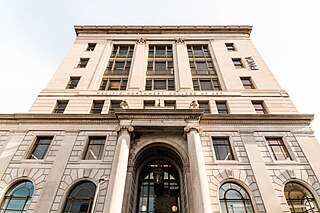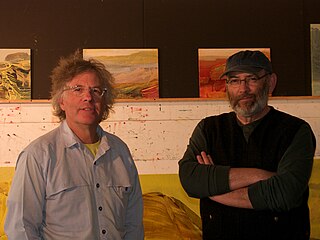Artwork
Watt works primarily with blankets as a material in her installation and collaborative works. She also prints lithography. For her sculpture and installation, she uses a variety of materials, including everyday objects, as well as textiles, alabaster, slate, and cornhusks. She cites Pop art, Abstract Expressionism, and indigenous visual traditions as sources for her work. [7] Watt had a studio in Portland, Oregon and started experimenting with materials, such as corn husk, then began experimenting with woven blankets. [4] In 2002, her stone sculpture Pedestrian was installed along the east bank of the Willamette River in Portland. Her work has appeared in several exhibitions in the Pacific Northwest. [8]
Watt involves community effort when creating artworks. Her project Blanket Stories: Transportation Object, Generous Ones at the Tacoma Art Museum involved creating large-scale installations out of blankets donated by the community. [9] Not only are the blankets the medium but "Watt believes that blankets provide access to social connections, historical traditions, and cross-cultural meanings." [9] Watt hosts sewing circles, groups who gather and work such as with the piece Forget me not: Mothers and Sons in which they constructed portraits of servicemen (and one woman) from Oregon killed in the Iraqi war. [10]
Career
In September 2004, as part of the Continuum 12 artists series, an exhibit of her work opened in New York City and the George Gustav Heye Center of the National Museum of the American Indian. The exhibit included Blanket Stories, a sculpture made of two towers of wool blankets, with each stack sewn together with a central thread. She collected the blankets over several years, including many Hudson's Bay point blankets that were given to Native Americans in trade by the Hudson's Bay Company during the 19th century.
In 2011, the Bill & Melinda Gates Foundation commissioned Watt to produce a site-specific artwork for their Seattle campus. [5] The work, entitled Blanket Stories: Matriarch, Guardian and Seven Generations, is a 14-foot column of wool blankets from all over the world and is located in the building's lobby. Describing how the materials fit this specific location, Watt wrote, "It's the first column I've made with the explicit goal of collecting and integrating blankets from around the world, echoing the Foundation's global mission; the column will be constructed of reclaimed blankets and reclaimed cedar, in resonance with the campus' goal of attaining LEED Gold certification." [11]
In 2014, 350 people contributed to an outdoor sculpture at Tacoma Art Museum. The towers she made were cast in bronze and she posted a micro-website with stories behind each blanket. Watt listens to her material and pulls from a deep sense of community and narrative to create works with history. Her works are both figurative and abstract. [4]
From 2017–2023, Watt served as a member of the Board of Directors for VoCA (Voices in Contemporary Art), a non-profit organization dedicated to the preservation of contemporary art.
Watt is currently a professor at Portland Community College, and is the coordinator of its Northview Gallery. She is represented by PDX Contemporary Art in Portland, Oregon, Catharine Clark Gallery in San Francisco, California, and Marc Straus Gallery in New York City, New York. [12]

The Pacific Northwest College of Art (PNCA) is an art school of Willamette University and is located in Portland, Oregon. Established in 1909, the art school grants Bachelor of Fine Arts degrees and graduate degrees including the Master of Fine Arts (MFA) and Master of Arts (MA) degrees. It has an enrollment of about 500 students. The college merged with Willamette University in 2021.
Rina Banerjee is an Indian-American artist and sculptor. She currently lives and works in New York City. Her ambitious mid-career survey exhibition, Make Me a Summary of the World––co-organized by and exhibited at the Pennsylvania Academy of the Fine Arts and the San Jose Museum of Art––opened in 2018 and is slated to travel to the Fowler Museum at UCLA, the Frist Art Museum in Nashville, TN, and the Nasher Museum of Art at Duke University, Durham, NC through July 2021.
The Museum of Contemporary Craft (1937-2016) in Portland, Oregon was the oldest continuously-running craft institution on the west coast of the United States until its closure in 2016. The museum's mission was "to enliven and expand the understanding of craft and the museum experience." It was known as one of the few centers in the United States to focus on the relationships between art and craft, programming robust shows exploring a wide variety of artists, materials and techniques.
Gail Tremblay was an American writer and artist from Washington State. She is known for weaving baskets from film footage that depicts Native American people, such as Western movies and anthropological documentaries. She received a Washington State Governor's Arts and Heritage Award in 2001.

James Lavadour is an American painter and printmaker. A member of the Walla Walla tribe, he is known for creating large panel sets of landscape paintings. Lavadour is the co-founder of the Crow's Shadow Institute of the Arts.
I believe that a painting must stand up on its own without explanation. I think of myself as an abstract action painter. I just happen to see landscape in the abstract events of paint. - James Lavadour

Terry Roger Adkins was an American artist. He was Professor of Fine Arts in the School of Design at the University of Pennsylvania.
Joe Feddersen is a Colville sculptor, painter, photographer and mixed-media artist. He is known for creating artworks strong in geometric patterns reflective of what is seen in the environment, landscape and his Native American heritage.
Lillian Pitt is a Native American artist from the Columbia River Plateau region of the Pacific Northwest. Her Native American name is Wak'amu, chosen because it represents a "stubborn plant that won't let go of the earth", referring to the long periods of time she spent wandering the hills during her childhood. Pitt is primarily known for her sculpting and mixed media artistry, which focuses on 12,000 years of Native American history and tradition of the Columbia River region.

Andrea Chung is an American artist born in Newark, NJ and currently works in San Diego, CA. Her work focuses primarily on island nations in the Indian Ocean and the Caribbean Sea; specifically on how outsiders perceive a fantastic reality in spaces deemed as “paradise”. In conjunction, she explores relationships between these cultures, migration, and labor - all within the context of colonial and postcolonial regimes. Her projects bring in conscientious elements of her own labor and incorporate materials significant to the cultures she studies. This can be seen in works such as, “Bato Disik”, displayed in 2013 at the Helmuth Projects, where the medium of sugar represents the legacy of sugar plantations and colonial regime.

Wendy Red Star is an Apsáalooke contemporary multimedia artist born in Billings, Montana, in the United States. Her humorous approach and use of Native American images from traditional media draw the viewer into her work, while also confronting romanticized representations. She juxtaposes popular depictions of Native Americans with authentic cultural and gender identities. Her work has been described as "funny, brash, and surreal".
Dyani White Hawk is a contemporary artist and curator of Sicangu Lakota, German, and Welsh ancestry based out of Minnesota. From 2010 to 2015, White Hawk was a curator for the Minneapolis gallery All My Relations. As an artist, White Hawk's work aesthetic is characterized by a combination of modern abstract painting and traditional Lakota art. White Hawk's pieces reflect both her Western, American upbringing and her indigenous ancestors mediums and modes for creating visual art.

Robert Henry Hess was an American sculptor and art educator. He was best known for his abstract metal sculptures and wood carvings. Hess served on the faculty of Willamette University in Salem, Oregon, for 34 years. Today, his works are found in prominent public spaces and private collections throughout the Pacific Northwest.
Tannaz Farsi is an Iranian-born American multidisciplinary visual artist and educator. Farsi is an Associate Professor of sculpture at the University of Oregon. She lives in Eugene, Oregon.
Charlene Liu is an American artist living and working in Oregon. "Using printmaking, painting, and papermaking processes, Liu samples and juxtaposes cultural references and the natural environment in an attempt to reconcile matters of biography and place."
Emily Ginsburg is a conceptual artist who lives in Portland, Oregon. She was selected for the Portland2016 Biennial by curator Michelle Grabner. And her work was noted as a highlight of the Oregon Biennial in 2006. Jennifer Gately, the curator of that Biennial, noted that Ginsburg's work, "reveals a deep interest in the signs and symbols of communication, scientific illustration, architectural notation, electronics, and the human nervous system." Ginsburg's "work often functions as a map or code for understanding an aspect of an individual or collective consciousness."
Meryl McMaster is a Canadian and Plains Cree photographer whose best-known work explores her Indigenous heritage. Based in Ottawa, McMaster frequently practices self-portraiture and portraiture to explore themes of First Nations peoples and cultural identity, and incorporates elements of performance and installation to preserve her mixed heritage and sites of cultural history in the Canadian landscape.
Natalie Ball is a Klamath/Modoc interdisciplinary artist based in Chiloquin, Oregon.

María Berrío is a Colombian-born visual artist working in Brooklyn, New York. The LA Times wrote that Berrío's large-scale collage works, "meticulously crafted from layers of Japanese paper, reflect on cross-cultural connections and global migration seen through the prism of her own history." She is known for her use of Japanese print paper, which she cuts and tears to create collages with details painted in with watercolour. Berrío, who spent her childhood in Colombia and moved to the US in her teens, draws from Colombian folklore and South American literature. In her interview with The Georgia Review in 2019, the artist discusses the tradition of aluna of the Kogi people in her work Aluna (2017). Berrío's collages are characterised by representations of mainly women, who often stare back at the viewer.
Brenda Mallory is a Native American visual/sculpture/mixed media/installation artist and a member of the Cherokee Nation. Her artwork ranges from small decorations to large sculptures and utilizes a variety of materials such as handmade papers, cloth, wax, and recycled objects.

Allison Janae Hamilton is a contemporary American artist who works in sculpture, installation, photography and film.







